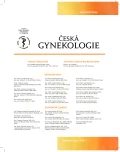Septic shock in pregnancy on the basis of an acute pyelonephritis
Authors:
Z. Kokrdová; A. Pařízek; M. Koucký; A. Pašková; B. Boudová
Authors‘ workplace:
Gynekologicko-porodnická klinika VFN a 1. LF UK, Praha, přednosta prof. MUDr. A. Martan, DrSc.
Published in:
Ceska Gynekol 2016; 81(4): 286-288
Overview
Objective:
According to the World Health Organisation, sepsis is one of the four main causes of pregnancy-related mortality worldwide, together with hemorrhage, hypertensive disease and abortion. The main goal of this paper is an analysis of one case of septic shock in pregnancy.
Design:
A case report.
Setting:
Department of Obstetrics and Gynaecology of the First Faculty of Medicine and General Teaching Hospital, Prague.
Methods and results:
Authors would like to draw attention to the pitfalls of diagnosis and treatment of septic shock which developed in 25th week of pregnancy on the basis of pyelonephritis due to E. coli.
Conclusions:
Early diagnosis of sepsis and an interdisciplinary co-operation are the main prerequisities for successful treatment.
Keywords:
sepsis and pregnancy, septic shock, urinary tract infection, antenatal bacterial infection, systemic inflammatory response syndrom
Sources
1. Acosta, CD., Kurinczuk, JJ., Lukas, DN., et al. Severe maternal sepsis in the UK, 2011–2012: A national case-control study. PLoS Med, 2014, 11(7), p. e1001672.
2. Cordioli, RL., Cordioli, E., Negrini, R., Silva, E. Sepsis and pregnancy: do we know how to treat this situation? Rev Bras Ter Intensiva, 2013, 25(4), p. 334–344.
3. Cunningham, FG., Lucas, MJ., Hankins, GD. Pulmonary injury complicating antepartum pyelonephritis. Am J Obstet Gynecol, 1987, 156(4), p. 797–807.
4. Dellinger, RP., Levy, MM., Rhodes, A., et al. Surviving sepsis campaign: international guidelines for management of severe sepsis and septic shock. Intensive Care Med, 2012, 39, p. 165–228.
5. Glasser, AP., Schaeffer, AJ. Urinary tract infection and bacteriuria in pregnancy. Urol Clin North Am, 2015, 42(4), p. 547–560.
6. Knight, M., Lewis, G., Acosta, CD., et al. Maternal near-miss case reviews: the UK approach. BJOG, 2014, 121 (Suppl. 4), p. 112–116.
7. Kramer, HM., Schutte, JM., Zwart, JJ., et al. Maternal mortality and severe morbidity from sepsis in the Netherlands. Acta Obstet Gynecol Scan, 2009, 88(6), p. 647–653.
8. Myburgh, JA., Finfer, S., Bellomo, R., et al. Hydroxyethyl starch or saline for fluid resuscitation in intensive care. N Engl J Med, 2012, 367(20), p. 1901–1911.
9. RCOG Green-top Guideline No. 64a: Bacterial sepsis in pregnancy. 2012. Available at: http://www.rcog.org.uk/guidelines.
10. Shah, A., Mohamed-Ahmad, O., McClymont, C., et al. Conditions triggering local incident reviews in UK hospital maternity units: A national survey. JRSM Open, 2014, 5(7), p. 1–5.
11. Wing, DA., Fassett, MJ., Getahun, D. Acute pyelonefritis in pregnancy: an 18 years retrospective analysis. Am J Obstet Gynecol, 2014, 210 (3), p. 219.e1–6.
Labels
Paediatric gynaecology Gynaecology and obstetrics Reproduction medicineArticle was published in
Czech Gynaecology

2016 Issue 4
Most read in this issue
- Technique of pelvic and paraaortic lymphadenectomy
- Prague 1337: the first successful caesarean section in which both mother and child survived may have occurred in the court of John of Luxembourg, King of Bohemia
- Present properties of ultrasound diagnostics in urogynecology
- Fetal alloimmune thrombocytopenia in pregnant woman with anti-HPA-1a antibodies
